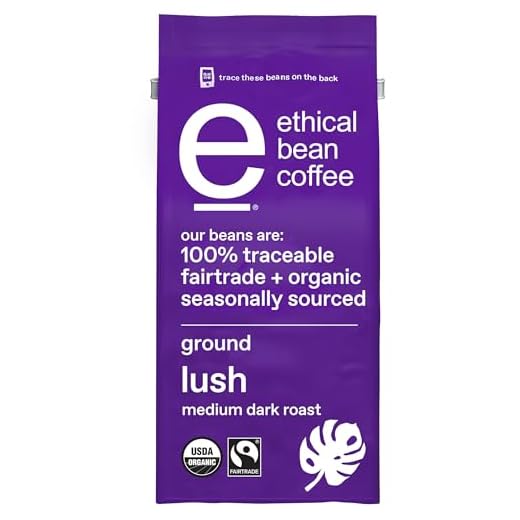



Single-origin coffee can feel like a treasure hunt or a maze, depending on where you start. You'll find options everywhere, from local roasters to online retailers, but not all beans tell the same story. Look for labels that reveal the farm, region, or even the elevation—details that hint at the flavors waiting in your cup. Yet, with so many choices, how do you know which beans will truly match your taste? The answer lies in understanding what's behind the label, and that's where the journey begins.
Key Takeaways
- Check labels for origin details like Ethiopia Yirgacheffe or Colombia Huila to identify single-origin coffee beans.
- Look for certifications such as Fair Trade, Organic, or Direct Trade to ensure ethical and sustainable sourcing practices.
- Explore online retailers or specialty shops offering detailed flavor profiles, roast levels, and processing methods for single-origin beans.
- Consider subscription services for regular delivery of seasonal or limited-edition single-origin coffees at discounted rates.
- Read tasting notes (e.g., blueberry, chocolate) and roast levels (light, medium, dark) to match your flavor preferences.
Understanding Single-Origin Coffee Labels
When you see a single-origin coffee label, it's more than just a name—it's a detailed map of the bean's journey from farm to cup. Single origin coffees highlight specific growing regions, like Ethiopia Yirgacheffe or Colombia Huila, where unique flavors emerge from distinct terroir. Labels often include roast levels—light, medium, or dark—and flavor notes such as blueberry, chocolate, or floral, guiding you to the bean's profile. Certifications like Fair Trade or Organic signal ethical sourcing, while Direct Trade guarantees a direct relationship with producers. Traceability details, such as farm names (e.g., Finca El Puente) or producer names (e.g., Wilson Zuleta), offer transparency. Seasonal availability may also appear, as single-origin coffees are harvested and roasted for peak freshness during specific times of the year.
Exploring Coffee Regions and Flavor Profiles
Single-origin coffee beans showcase the distinct characteristics of their growing regions, shaped by terroir—climate, altitude, and soil composition. In Sumatra, you'll find earthy, full-bodied coffees, while Ethiopian Harrar beans reveal fruity and floral undertones. Colombian Huila offers balanced acidity with caramel sweetness, and Guatemalan Huehuetenango delivers complex, wine-like flavors. African coffee-growing regions like Kenya's Nguvu and Ethiopia's Yirgacheffe are celebrated for vibrant acidity and unique characteristics tied to their high-altitude cultivation. Central American coffees, such as Costa Rica Tarrazu and Guatemala Bella Carmona, highlight bright acidity and nuanced profiles influenced by volcanic soil and microclimates. Each single-origin coffee reflects its region's terroir, allowing you to explore diverse flavor profiles shaped by geography and farming practices.
Identifying Direct Trade and Ethical Sourcing
To guarantee your coffee aligns with ethical sourcing standards, start by examining certifications like Fair Trade, Rainforest Alliance, or Direct Trade, which signal adherence to sustainable and equitable practices. Look for roasters that establish long-term relationships with farmers, often detailed on their websites or packaging. Transparency is key—check for information about the farm, region, or cooperative where the beans were grown. Prioritize brands that pay premiums above market prices, securing fair wages and sustainable farming. Verify traceability through lot numbers or farm names, confirming Direct Trade relationships. These practices not only support ethical sourcing but also enhance the quality and story behind your single-origin coffee. By focusing on these details, you secure your purchase supports both farmers and the environment.
Using Online Retailers and Specialty Shops
While exploring single-origin coffee options, online retailers and specialty shops provide access to meticulously sourced beans from specific regions, often accompanied by detailed flavor profiles and sourcing information. You'll find single-origin coffees from Bali, Brazil, and Ethiopia at retailers like The Coffee Bean & Tea Leaf, starting at $17.25. Specialty shops such as 1000Faces Coffee offer beans like Ethiopia Biranu Dulo Natural, priced at $24.00 for 12 oz, with precise tasting notes. Platforms like Klatch Coffee feature options such as WBC World's Best Espresso for $19.95 per 310 grams. Subscription services, like Counter Culture's $35 two-bag offering, let you explore seasonal single-origin coffees. JBC Coffee Roasters highlights limited releases, such as Kenya Kariaini, at $23.00 for 12 oz, ensuring transparency in sourcing and quality.
Reading Tasting Notes and Roaster Profiles
When reading tasting notes, you'll encounter descriptors like "blueberry" or "milk chocolate," which highlight the coffee's flavor profile and help you identify preferred tastes. Roaster profiles often specify roast levels—light, medium, or dark—and processing methods, such as natural or washed, which directly influence the coffee's acidity and body. Pay attention to origin details, like Ethiopia or Colombia, as they reveal regional flavor characteristics shaped by terroir and processing techniques.
Understanding Flavor Profiles
Understanding flavor profiles in single-origin coffee beans begins with analyzing tasting notes and roaster profiles, which serve as a roadmap to the coffee's sensory characteristics. Flavor descriptors like "blueberry, lavender, sugar cookie" on Ethiopia Biranu Dulo Natural reveal the fruit-forward and floral qualities unique to single-origin coffees. Acidity descriptions, such as "bright" for Ethiopia Mukwinja or "mellow" for Noyo Harbor French Roast, indicate the intensity and type of acidity, ranging from vibrant to subdued. Roaster profiles often detail body and acidity levels, like the "creamy body" and "clean, vibrant acidity" of Colombia Geiner Montano. These elements, combined with descriptors such as "cherry pie, vanilla, milk chocolate" on Guatemala Wilson Zuleta, help you identify the sweetness, complexity, and balance of the coffee's flavor profile.
Identifying Roast Characteristics
Identifying roast characteristics in single-origin coffee beans involves interpreting tasting notes and roaster profiles to uncover how roast levels and processing methods shape flavor. Start by examining roast levels—light, medium, or dark—to align with your flavor preferences. A light roast highlights bright acidity and floral notes, while a dark roast emphasizes bold, smoky tones. Processing methods, like natural or washed, further influence flavor; naturals often yield fruity complexity, while washed coffees tend to be cleaner and more balanced. Check roaster profiles for details on body (e.g., velvety, syrupy) and acidity (bright, mellow) to refine your choice. For example, a medium-light roast Ethiopian natural might offer vibrant blueberry and lavender notes, while a dark roast Colombian could deliver a creamy, full-bodied experience.
Exploring Regional Influences
While tasting notes and roaster profiles provide a roadmap to a coffee's flavor, they also reveal how regional influences shape single-origin beans. Ethiopian coffee, like the Biranu Dulo Natural, often showcases fruity and floral notes such as blueberry and lavender, a result of its natural processing method. In Latin America, Costa Rica and Guatemala produce beans with vibrant acidity and balanced sweetness, as seen in descriptors like "cherry pie" and "milk chocolate." These profiles reflect high-altitude growing conditions and meticulous processing. Roasters like JBC Coffee Roasters highlight Ethiopian Mukwinja's citrus-forward notes, while Temple Coffee emphasizes Colombia Geiner Montano's clean acidity and turbinado sugar undertones. By studying these details, you'll uncover how terroir and regional practices define each bean's unique character.
Subscribing to Single-Origin Coffee Services
Subscribing to single-origin coffee services allows you to explore distinct flavor profiles, such as blueberry or orange, while ensuring access to freshly roasted, ethically sourced beans from specific regions like Ethiopia or Colombia. These services, like Counter Culture Coffee, prioritize traceability, connecting you directly to farms or regions for unparalleled transparency. Roasters such as 1000Faces Coffee and JBC Coffee Roasters curate unique, seasonal offerings, letting you experience the best of regional diversity year-round. By subscribing, you secure consistent access to high-quality, single-origin coffee, often at a discounted rate compared to non-subscription pricing. This model not only supports sustainable farming practices but also guarantees you receive beans at their peak freshness, enhancing your brewing experience with every cup.
Comparing Pricing and Subscription Options
When exploring single-origin coffee subscriptions, you'll find that the pricing structure is designed to offer both value and convenience. For example, subscribing to two bags of single-origin coffees costs $35, compared to $44 for non-subscription purchases. This best-selling subscription option, identified by Product ID 6732362416205, guarantees your coffee comes regularly, enhancing your coffee experience without the hassle of reordering. The add-to-cart functionality simplifies the process, making it easy to secure your preferred subscription. If you prefer flexibility, non-subscription pricing allows for one-time purchases, though it lacks the cost savings of a subscription. By comparing these options, you can choose the approach that best aligns with your preferences, securing a seamless and enjoyable way to enjoy high-quality single-origin coffee.
Experimenting With Different Origins and Roasts
To fully appreciate the nuances of single-origin coffee, you'll want to explore beans from diverse regions, each offering distinct flavor profiles shaped by their unique terroir. Start with Ethiopian single-origin coffees for vibrant fruity and floral notes, or Sumatra for earthy, full-bodied undertones. Colombian beans often deliver balanced acidity with caramel sweetness. Experiment with light, medium, and dark roasts to see how each enhances regional flavor differences—light roasts highlight bright, complex notes, while dark roasts emphasize bold, smoky tones. Compare African coffees like Kenya Nguvu with Central American options like Costa Rica Tarrazu to identify terroir-driven contrasts. Seasonal offerings, such as Ethiopian Yirgacheffe or Tanzanian Peaberry, provide insight into harvest timing's impact. Use subscription services to regularly sample new single-origin coffees and refine your preferences.
Disclosure: As an Amazon Associate, I earn from qualifying purchases.




